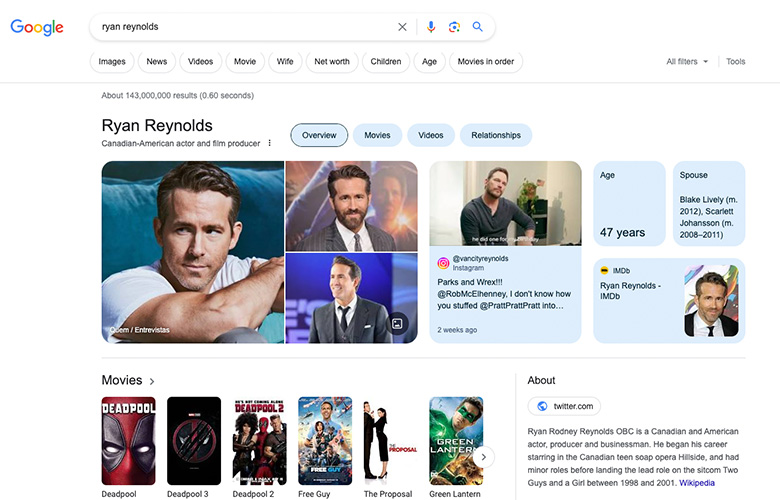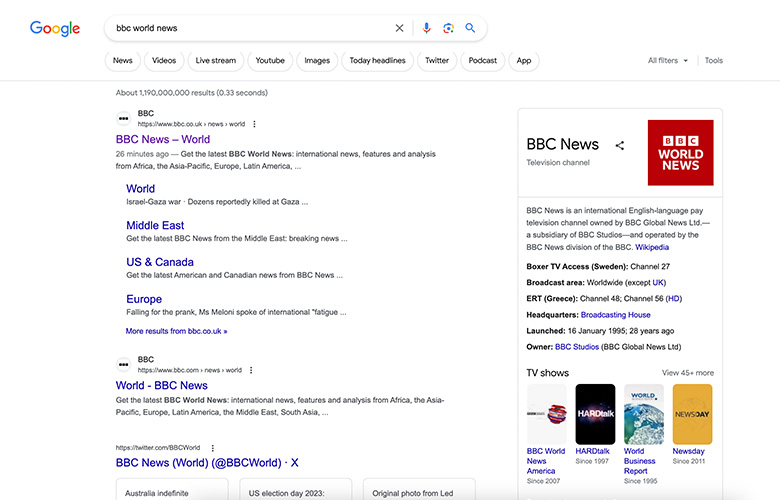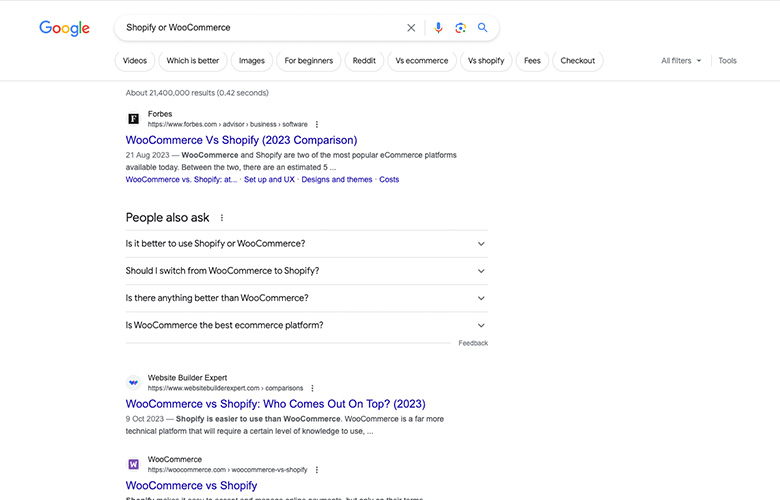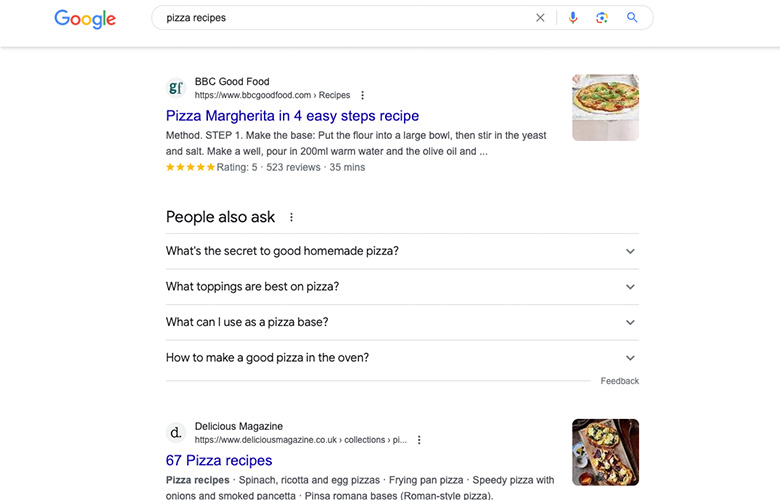If you own a business you want your website to be seen on Google to help your business attract new leads and sales.
However, ranking high on page one for Google is becoming increasingly challenging – and fiercely competitive.
This article explores how understanding user intent can help you write content that gives you a better chance of your website being seen online.
What is search (user) intent?
Search intent, also referred to as user intent, defines the fundamental objective that drives a user’s search query in a search engine. Often, users seek a particular kind of answer or resource during their search.
Let’s use pizza as an example. 🍕
A user searching for a pizza for a Saturday night takeaway has a distinct and different intent compared to searching about the origins and history of a pizza.
Again, the user would have a different intent if they were searching for a recipe to make a pizza.
All these searches are related to the overarching topic of pizza. However, each of these users are exhibiting varying intentions.
Unfortunately, owning a website isn’t like the late ’80s film ‘Field of Dreams’.
You can’t just build a website and expect visitors to come.
You need to put some real thought and effort into what your users are searching for.
Why is search (user) intent important for your website’s Google search engine rank?
Search intent is crucial for the visibility of your website in Google search. This is because Google’s primary goal is to provide users with the most relevant and valuable search results.
Google knows when a user carries out a search and doesn’t find what they are looking for. They get a signal sent back each time this happens, and it is these signals that help the search engine giant understand that the intent and results are likely mismatched.
When your content aligns with search (user) intent, it significantly benefits your Google ranking for several reasons:
- Relevance: Google ranks content based on its relevance to user intent. When your content aligns with search intent, it’s more likely to rank well.
- User Satisfaction: Meeting user intent enhances user experience and lowers bounce rates, improving your site’s authority.
- Lower Bounce Rates: Relevant content reduces bounce rates, indicating to Google that your content is engaging and on target.
- Improved Click-Through Rates (CTR): Effective content alignment with user intent boosts CTR, positively influencing ranking.
- Google’s Algorithm Updates: Google updates algorithms to grasp user intent, as seen with BERT and RankBrain, stressing content-intent alignment.
- Keyword Variations: Optimising for diverse keywords covers multiple intents and broadens your audience reach.
- Feature Snippets and Results: Creating intent-matching content boosts your chances of appearing in Google’s featured snippets and rich results for specific queries.
- Voice Search and Mobile Search: Voice search and mobile usage make grasping search intent crucial, as users ask intent-focused questions and have immediate needs.
💡 Did you know?
Google gets a signal sent back when a user carries out a search and doesn’t find what they are looking for
What are the different types of search (user) intent?
There are an infinite amount of queries that you can enter into Google. However, there are four primary search intents:
- Informational
- Navigational
- Preferential/Commercial Investigation
- Transactional
1. Informational
This one is pretty straightforward. It’s users who are seeking information or answers to questions. As you would expect, this search intent type is very common, as users are constantly looking up answers to questions.
It’s important to note that all search queries that have informational intent are posed as a question. Users will often just search for the name of a person to bring up information about that person.
Example informational intent search queries:
- “How to tie a bow tie”
- “What is climate change?”
- “Ryan Reynolds”
- “Directions to Covent Garden”

2. Navigational
These users want to find a specific page or site. The specific destination they have in mind is reflected within their search query.
Example navigational intent search queries:
- “Netflix login”
- “Facebook homepage”
- “BBC World News”
- “Newsjacking guide Stamford Digital“

3. Preferential/Commercial Investigation
This is when the user wants to investigate brands, products or services further. Think of these users as window shoppers, comparing products and prices, features and reviews to find the best option for them.
Example preferential/commercial intent search queries:
- “iOS vs Android”
- “best website designer near me”
- “Paid Ads vs Organic”
- “Shopify or WooCommerce”

4. Transactional
These users already have a good idea of what they want and are displaying a desire to make a purchase or take a specific action. This could be to buy a product, service or subscription.
Often their search query is very specific and contains the brand name related to the product or service.
Example of transactional intent search queries:
- “Buy iPhone 15”
- “Book a flight to New York”
- “Sign up for digital marketing course”
- “Buy Nike Air Jordans Mid Mens Shoes”

How can I determine search intent?
Here are ten methods that can help you determine search (user) intent:
1. Analyse the Query
Start by carefully examining the search query itself. Look for specific keywords or phrases that hint at what the user is looking for, such as “buy,” “how to,” “best,” “information about,” etc.
2. Review Search Results
Perform the search query yourself and review the search results. Pay attention to the type of content that ranks well. Are the top results informational articles, product listings, or local business pages?
3. Use “People Also Ask” and “Searches Related To”
Scroll down on the search results page to find the “People also ask” and “Searches related to” sections. These often provide additional related queries that can help you understand the context and intent behind the original search.
4. Keyword Research Tools
Utilise keyword research tools like Google Keyword Planner, SEMrush, Ahrefs, Moz, or Ubersuggest to identify popular keywords related to your topic. These tools can offer insights into the search volume and competition, which can indirectly indicate intent.
5. User Behaviour Analysis
If you have access to website analytics, study how users interact with your site. Analyse which pages they land on from search results and monitor engagement metrics to understand whether your content aligns with their intent.
6. Content and Format
Consider the type of content that ranks well for your target keywords. Are they blog posts, product pages, videos or images? The content type and format can indicate intent.
7. Content and Trends
Keep up with current trends and the broader context of your industry or niche. What are the common questions, issues or interests of your target audience? Understanding these can help you anticipate intent.
8. User Surveys and Feedback
Directly engage with your audience through surveys, feedback forms or social media to better understand their intent and the information they seek when using search engines.
9. Competitor Search Intent Types
Study your competitors and their content strategies. What types of content are they creating, and what keywords are they targeting? This can reveal common intent themes in your industry.
10. Common Search Intent Types
Familiarize yourself with the common search (user) intent types mentioned in this article (informational, navigational, transactional, etc.) and their characteristics. This can serve as a foundation for understanding user intent.
⚡️ Action Point
See if you can spot intent types the next time you search on Google.
How do I optimise my web pages for search intent?
Here are five tips on how to optimise your web pages for search (user) intent:
Match meta titles and descriptions to the search intent
Matching meta titles and descriptions to search intent offers benefits:
- Improved Click-Through Rates (CTR): When your meta titles and descriptions align with the user’s search intent, they are more likely to click on your search result.
- Reduced Bounce Rate: If your meta title and description accurately reflect your content and meet user expectations, visitors are less likely to leave your site immediately after arriving, which reduces your bounce rate.
- Rich Snippet Opportunities: For example, Google may use the meta description as the basis for rich snippets in search results. When your meta description matches the intent and is informative, you increase the chances of being featured in rich results like featured snippets or “People Also Ask” boxes.

- Higher Conversion Rates: Aligning your meta tags with search intent helps you attract visitors who are genuinely interested in your content or products. This can lead to higher conversion rates, as you are targeting an audience with a higher likelihood of engaging with your content or making a purchase.
- Increased Trust and Credibility: When users see that your meta tags match their intent, it can build trust and credibility. They are more likely to perceive your website as reliable and authoritative, which can lead to repeat visits and conversions.
- Better Rankings: Google and other search engines consider user engagement signals, such as CTR and bounce rate, when determining the relevance and quality of your page. When you have higher CTR and lower bounce rates due to matching meta tags, it can positively impact your search engine rankings.
Match the headers within your content to the search intent
Ensure your title tag, H1, and H2s reflect the specific keyword you are targeting. Matching headers can help search engines better grasp the context and relevance of your content to specific search queries and it will also improve the overall user experience.
Take accessibility seriously
Taking accessibility seriously within your web content is not only a responsible practice but also beneficial for SEO and user experience. For example, taking time to ensure image alt tags have a correct and informative description is a crucial aspect of web accessibility. The BBC do a very good job of providing descriptive alt tags on images. I recommend you take a look at their image alt tags to get an idea of the level you need to strive for.
Format content for SERP features
It’s a good move to format your content to appear in SERP (Search Engine Results Page) features. SERP features, such as featured snippets, knowledge panels, image carousels and more, provide enhanced search results that stand out and can attract more attention from users.
Check out your competitors
Make sure you take a look around you at your competitors. After all, you are all vying for a coveted spot on page one of Google.
- What keywords are they covering?
- How are they formatting their web content?
- What points are they covering?
- What are they missing?
💡 Stamford Digital Tip
Use tools like Moz, SEMRush and AnswerThePublic to help you analyse your competitors and their approach to content.
Provide a great user experience (UX)
Users appreciate when search results provide them with the information they need. Google looks a various signals to determine if your site is providing a good user experience. The better the experience the better chance you have of ranking higher on Google.
Key takeaways
When you’re creating SEO content with search (user) intent in mind, remember the following:
- Do your research: You need to first determine what is the search (user) intent.
- Look at SERPs: Work out the best way to format and provide content.
- Provide value: Don’t build for the Google search algorithm. Instead, focus on writing and providing valuable content for your users and audience.
So, as you’ve just found out, creating SEO-optimised content for specific search (user) intents isn’t rocket science, but does take work.
The next time you sit down to create some content for your website, consider the user’s mindset and search intent. Do this and you will be creating something that stands a better chance of resonating with your audience and ranking better on Google.
Did you find this article informative and insightful? If so, we would appreciate you sharing this article with your network.
Please feel free to contact us if you have any questions about how you can improve the visibility of your website in Google.



